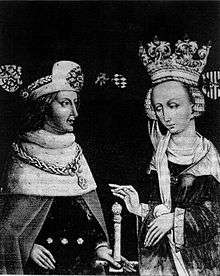Rupert II, Elector Palatine
| Rupert II, Elector Palatine | |
|---|---|
 Rupert with his wife Beatrice | |
| Born |
12 May 1325 Amberg |
| Died |
6 January 1398 (aged 72) Amberg |
| Buried | Cistercian monastery in Heidelberg |
| Noble family | Wittelsbach |
| Spouse(s) | Beatrix of Sicily |
| Father | Adolf, Count Palatine of the Rhine |
| Mother | Irmengard of Oettingen |
Rupert II, Count Palatine of the Rhine (German: Ruprecht II., der Harte (der Ernste)) (12 May 1325, Amberg – 6 January 1398, Amberg). He was the Elector Palatine of the Rhine from the house of Wittelsbach in 1390–1398.
He was the elder son of Adolf, Count Palatine of the Rhine and Countess Irmengard of Oettingen. On 13 February 1338 the Palatinate was divided between Rupert II and his uncle Rudolf II, Duke of Bavaria. After the death of his other uncle, the Elector Rupert I (who had succeeded Rudolf II), on 16 February 1390 he was proclaimed Elector Palatine with the consent of Wenceslaus, King of the Romans. In 1391 he banished Jews and prostitutes from the Palatinate, confiscated their property, and bequeathed it to the Ruprecht Karl University of Heidelberg. In 1395 he promulgated the so-called Rupertinische Konstitution which was intended to provide for unity of the Palatinate. Among other provisions, he incorporated to his realm the former Imperial Free City Neckargemünd.
He was buried in Schönau Abbey a Cistercian monastery in Heidelberg.
Family and children
He was married in 1345 to Beatrix of Sicily and Aragon, daughter of King Peter II of Sicily. They had the following children:
- Anna (1346 – 30 November 1415), married in 1363 to William VII of Jülich, 1st Duke of Berg.
- Friedrich (1347 – c. 1395).
- Johann (1349 – c. 1395).
- Mechthild (born 1350), married to Landgrave Sigost of Leuchtenberg.
- Elisabeth (c. 1351 – 1360).
- King Rupert of Germany (1352 – 1410).
- Adolf (1355 – 1 May 1358).
| Rupert II, Elector Palatine Born: 12 May 1325 Died: 6 January 1398 | ||
| German royalty | ||
|---|---|---|
| Regnal titles | ||
| Preceded by Rupert I |
Elector Palatine 1390–1398 |
Succeeded by Rupert III |